What’s New
September 2025
Three New Fact Sheets Published Online
Volutella Blight of Pachysandra Black Rot of Brassicas
August 2025
Biologia y manejo actualizado de la Enfermedad de las Hojas de Haya
Updated Beech Leaf Disease Biology and Management in Spanish was published on CAES website. See linke above and below.
June 2025
Updated Beech Leaf Disease Biology and Management (Updated May 2025)
May 2025
Anthracnose Prevalent on Shade Trees
Cool and wet spring weather conditions favored anthracnose diseases on shade trees this year. For more details of this disease, please read the fact sheet Anthracnose Diseases of Trees.


Dogwood Anthracnose - Brown spots on leaves Oak anthracnose - Leaf blotch and curling of leaves
What Causes Brown Spots in My Lawn?
Red thread, an early-spring fungal disease, can cause pinkish brown spots in lawns. The linked fact sheet, Red Thread of Turfgrass, describes this disease and strategies for its control.


Pinkish brown spots in a lawn
------------------ * ---------------------- * -----------------------
Brown Rot Killing Twigs on Flowering Cherry Trees


Drooping and browning of small twigs on flwoering cherry trees, which are caused by Brown Rot
--------------------- * ------------------------- * ------------------------
April 2025
A New Fact Sheet - Weather Effects on Broad-Leaved Evergreens, 2024-2025
Curling of Leaves and Dying of Rhododendron Bushes after the Winter


The Plant Disease Information Office has been receiving numerous inquiries of winter injury on rhododendron bushes this year. Symptoms include curling of leaves and diebacks. For more information, linked please find a new fact sheet Weather Effects on Broad-Leaved Evergreens, 2024-2025.
March 2025
Be on the Lookout for Diseases on Bedding Plants


Powdery mildew on petunia Tomato spotted wilt virus on cineraria
Recently, we confirmed powdery mildew on petunia and tomato spotted wilt virus on cineraria from the bedding plant samples that were sent to the Plant Disease Information Office. Linked please find fact sheets, Powdery and Downy Mildews of Greenhouse Crops and Viral Diseases (TSWV/INSV) of Bedding Plants, that describe more details of these diseases. For plant disease diagnosis and confirmation, please send us samples by following the Samples Submission Guidelines.
January 2025
New Fact Sheet Published Online
Alternaria leaf spot is a common disease of brassica vegetables including broccoli, Brussels sprouts, cabbage, cauliflower, and kale. The disease attacks leaves, stems, curds/heads, seed pods, and seed. Severe infections may cause pre- and post-harvest yield loss and quality reduction, respectively. Read more details in the linked fact sheet Alternaria Leaf Spot of Brassicas
December 2024
New Fact Sheet Published Online – Bacterial Leaf Scorch of Shade Trees

Bacterial Leaf Scorch is a vascular disease capable of infecting a wide range of hosts, caused by the bacterium, Xylella fastidiosa. In October, the Plant Disease Information Office used an enzyme-linked immunosorbent assay (ELISA) to test for this disease on several samples received from local areas. Only one sample tested positive, a young swamp white oak tree in a landscape setting in Westchester County, NY. A new fact sheet on Bacterial Leaf Scorch of Shade Trees is available here.
White Pine - Brown Spot Needle Blight

Leaf Spot on Ornamental Trees and Shrubs

Cercospora leaf spot of hydrangea Black spot of rose Anthracnose of maple
The Plant Disease Information Office has received several plant samples recently showing symptoms of different fungal leaf spot diseases on a variety of host plants. Wet spring weather conditions increase the chance of new infection as leaf surfaces remain wet for a long period of time. For more information on leaf spot diseases on woody plants, please see our fact sheet Leaf Spot Diseases of Ornamental Trees and Shrubs.
Powdery mildew of woody ornamentals Powdery mildew of strawberry
Black Knot on Plum and Cherry
Are you seeing charcoal like swellings on the twigs of ornamental or fruiting cherry and plums? Recently, the Plant Disease Information Office has received several inquiries displaying what is known as black knot, a fungal disease of woody plants in the Prunus genus. For more information on this disease and management recommendations, you may follow this link to our fact sheet Black Knot of Ornamental Plum and Cherry.

New Fact Sheets Posted Online
Edema Black root rot of ornamentals
Two New Fact Sheets Published Online
Boxwood Blight is Back


Dark leaf spots Severe defoliation
CAES Scientists Release Updated Bulletin on Biology and Management of Beech Leaf Disease
August 2023
Wet Summer Weather Promotes Fungal Leaf spots on Woody Ornamentals
This summer, we have been experiencing frequent thunderstorms with heavy precipitation. Wet warm summer weather combined with high humidity creates a favorable environment for fungal diseases in landscapes and gardens. Our office received numerous inquiries and reports of fungal leaf spots. For more information, please check the link Leaf Spot Diseases of Ornamental Trees and Shrubs. For disease diagnosis, please send us samples and images by following Sample Submission Guidelines.


Septoria leaf spot of lilac Black spot of Elm
Two New Fact Sheets Published Online
Pine wilt Anthracnose of Strawberry
What's Wrong with My Eastern Red Cedar?

Watch for Beech Leaf Disease this Spring and Summer

Newly expanding beech leaves are already beginning to show symptoms of Beech leaf disease. More information can be found in the fact sheet: Beech Leaf Disease - Updates 2021.
New Fact Sheets of Boxwood Blight BMPS
Three New Fact Sheets are Online Now


Viral diseases of bedding plants Botrytis blight of blueberry
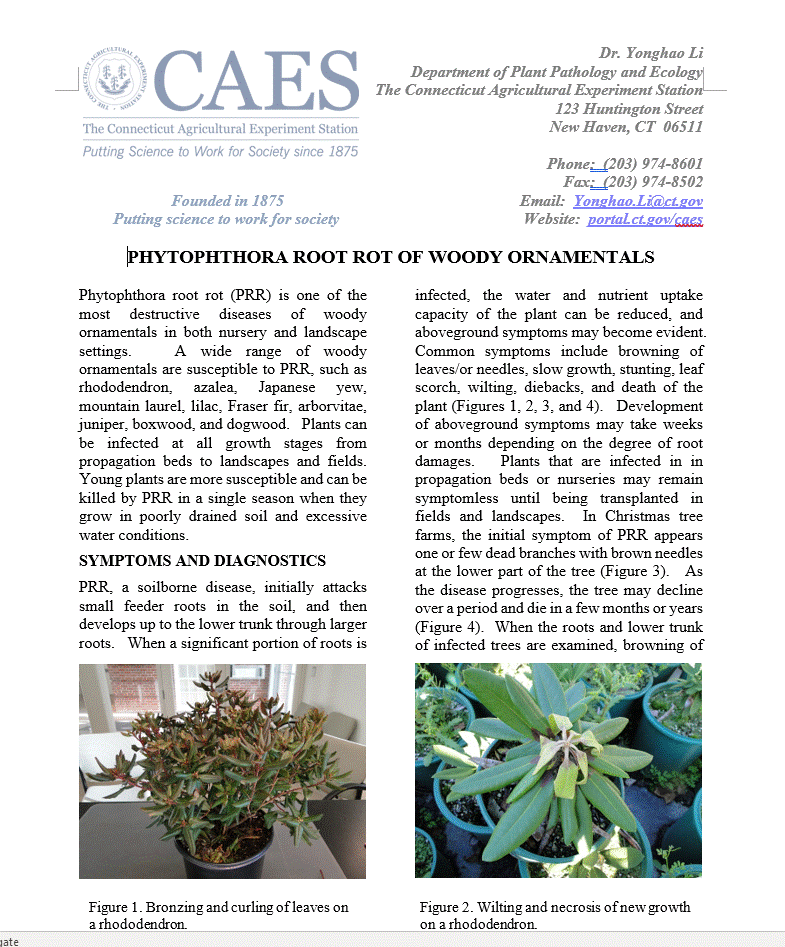
Phytophthora root rot of woody ornamentals
Browning of Leaves and Diebacks on Boxwood


Browning of leaves Blackening of stems and orange fungal structures
The Plant Disease Information Office has been receiving numerous boxwood samples with browning of leaves and stem diebacks. Volutella blight, a common fungal disease of boxwood, were found on most samples. Please find more information of this disease and its control in the fact sheet Volutella Blight of Boxwood. Heat and drought stress during this summer might also contribute to the damage.
Severe Damages on Pachysandra resulted from Volutella Blight in 2022

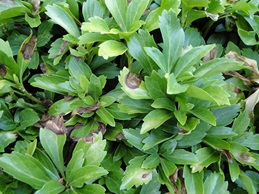
Beech Leaf Disease Widespread and Severe in Connecticut and the Northeast

PRESS RELEASE: Connecticut’s Beech Trees Severely Impacted by Beech Leaf Disease
Beech Leaf Disease Showed Up Early in 2022




Two New Fact Sheets Published Online
Dutch Elm Disease Fusarium Wilt of Tomato
Septoria Leaf Spot - Browning of Leaves in Late Summer


Septoria leaf spot is a minor foliar disease on maples. But, the wet and stormy weather during the growing season has been causing severe browning of leaves and early defoliation since late summer. Although it is cosmetic and has minimal long-term impacts on the trees, a widespread of this disease may affect brilliant fall color this year. For more details, please read linked fact sheet Common Diseases of Maple.
Watch for Boxwood Blight this Summer and Fall


Recent summer weather has been very conducive for boxwood blight, a devastating infectious disease on boxwood. Our office has been receiving numerous inquiries and boxwood blight positive samples since this summer. Please find the linked Boxwood Blight Identification Guide and watch for typical symptoms on established, newly installed, or newly purchased boxwoods. If you find suspected boxwood blight symptoms, please send us samples by following Sample Submission Guidelines for a lab examination and confirmation. More information of boxwood blight can be found in Boxwood Blight - Information and News.
New Fact Sheet - Beech Leaf Disease - Updates 2021

Beech leaf disease (BLD) was first discovered on American beech (Fagus grandifolia) in Lake County, Ohio, in 2012. BLD is now, in 2021, well-established in Ontario, Canada, and throughout much of northern Ohio, northwestern Pennsylvania, western and southern New York, eastern Massachusetts and several counties in Maine. In Connecticut, BLD was first found in 2019, in Fairfield County (Figure 1), and is now found in all counties except Hartford County, with the greatest severity occurring in Fairfield, New Haven, Middlesex, and New London Counties. The disease has been observed mainly in forests and private woodlots, but it has also been reported in landscaped areas. Find more details in the linked fact sheet, Beech Leaf Disease - Updates 2021.
Lesser celandine: An invasive plant with pretty yellow flowers

Lesser celandine (Ficaria verna), a native to Europe and parts of northern Africa and Asia, has been distributed throughout the northeastern United States. We have been receiving numerous phone calls and emails with inquires of lesser celandine this spring, which is raising the alarm that the invasive species appears to be spreading. For details of this invasive plant, please read the fact sheet Lesser Celandine (Ficaria verna Huds.) Identification and Management.
Snow Mold - The First Disease of the Year on Turfgrasses



After this long winter with a prolonged period of snow cover, snow mold is being found in many lawns across Connecticut. It is a fungal disease infects grasses in the late winter or early spring. After snow melts, circular whitish-gray patches appear on turfgrasses. Since most damaged grasses can recover when temperatures warm up in the spring, no fungicide treatments are necessary. Linked please find a fact sheet that describes this disease and strategies for its management. Common Diseases and Problems of Home Lawns.
New Fact Sheets Published Online (see links below)
1. Pythium Blight of Turfgrasses
Impatiens Downy Mildew Outbreak

The destructive disease impatiens downy mildew has been confirmed in CT this summer. Early symptoms of the disease begin as light-green yellowing, mottling, or stippling and often go unnoticed. Advanced symptoms include stunting of whole plants, downward curling of leaves, wilting, and severe defoliation that results in bare, leafless stems. The diagnostic sign of the disease is white "mildew" visible on the lower surface of diseased leaves. For more information, please see the fact sheet Downy Mildew of Impatiens . Plants suspected of having this disease should be sent to the PDIO for analysis. Linked please find the Sample Submission Guidelines.
A New Disease - Boxwood Dieback
Boxwood dieback was first reported in the United States in 2015 and has been detected in a number of states in the south and south eastern U.S. In August 2020, the disease was first detected in Connecticut. The characteristic symptoms of the disease are significant diebacks with brown leaves attached on stems (Figure 1), black fungal fruiting bodies on stems and leaves (Figure 2), and blackening of stem tissues (Figure 3). For the detailed information of the disease, please read the linked fact sheet, Boxwood Dieback.

Figure 1. Dieback


Figure 2. Black fungal fruiting bodies Figure 3. Blackening of stem tissues
Beech Leaf Disease Has Been Found in New Haven County, CT
Since beech leaf disease was first detected in Fairfield County, CT in 2019, it has been identified in New Haven County, CT in 2020. For details, please read Press Release CAES Announces First Report of Beech Leaf Disease in Hamden and New Haven, Connecticut and our fact sheet on Beech Leaf Disease.


Beech leaf disease and beech anthracnose in the spring 2020
----------*********----------
Outbreak of Maple Anthracnose - Spring Leaf Drop
Recently, numerous reports of spring leaf drop of maple trees have been received in our office. Fallen leaves were found on decks and lawns (see photos below). Yellowing and blackening of leaves were resulted from severe infection of maple anthracnose due to prolonged cold wet spring weather this year. Linked please read a fact sheet Common Diseases of Maple that describes this disease.


New Fact Sheets

----------*********----------
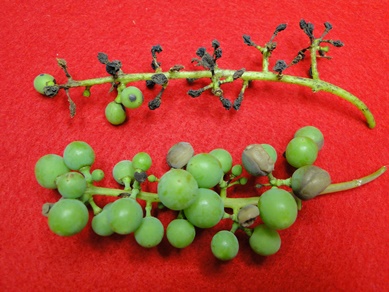
New Fact Sheet - Marssonina Blotch of Apple

Disease Alert: Beech Leaf Disease - A Disease Killing American Beech Trees
Beach leaf disease was first discovered in Ohio in 2012. It has since been found in Pennsylvania, New York, and Ontario, Canada in North America. In Connecticut, this disease was first detected in August 2019. The disease has been observed mainly in forests, but also in landscaped areas. For more information of this disease, please read a new fact sheet Beech Leaf Disease.

----------*********----------
A fact sheet: "Oak Wilt - An Invasive Pathogen on Connecticut's Doorstep! " written by Dr. Robert Marra.
-----------------------------------------------------------------------------------------------------------------------
A fact sheet "Delphinella Shoot Blight of Fir" was published online.

Fir trees infected by Delphinella shoot blight in a Christmas tree farm
July 2019
Disease Alert: Downy Mildew


Downy mildew of impatiens Basil downy mildew
Destructive downy mildew diseases were confirmed on impatiens and basil plants in residential gardens this summer. For detailed information of these diseases, please see our fact sheets Downy Mildew of Impatiens and Basil Downy Mildew.


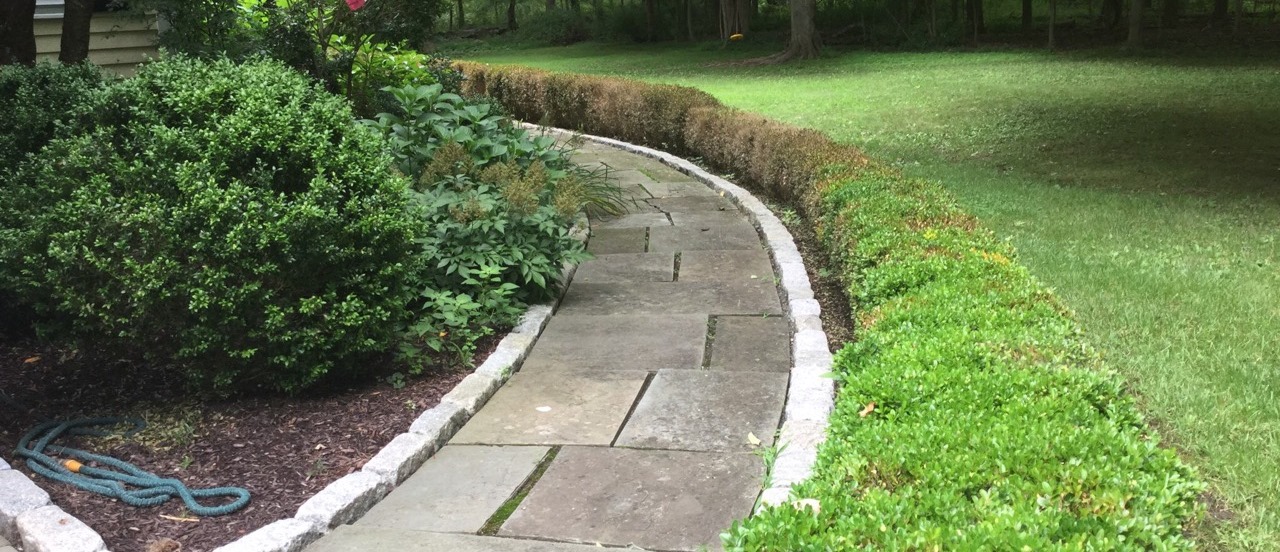
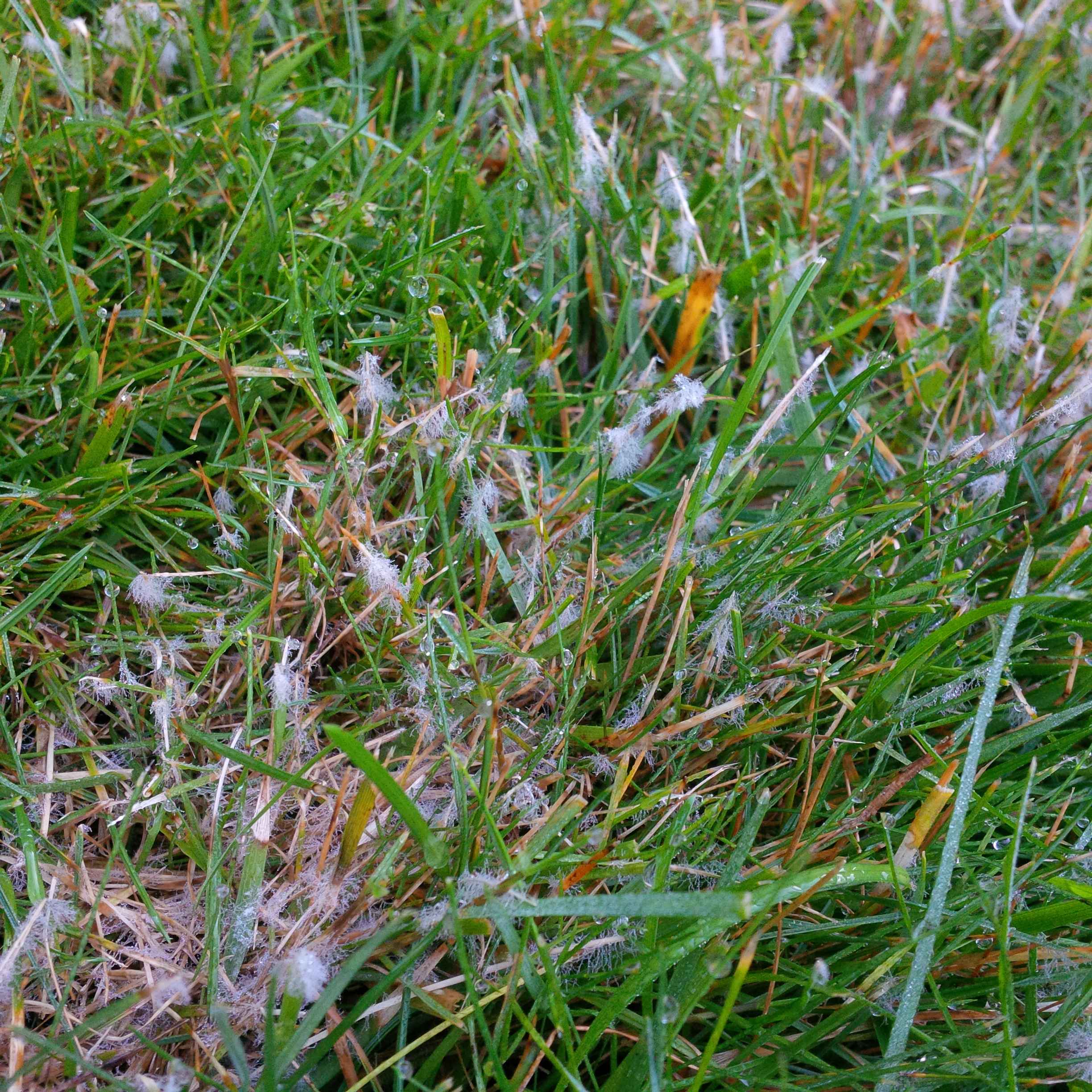
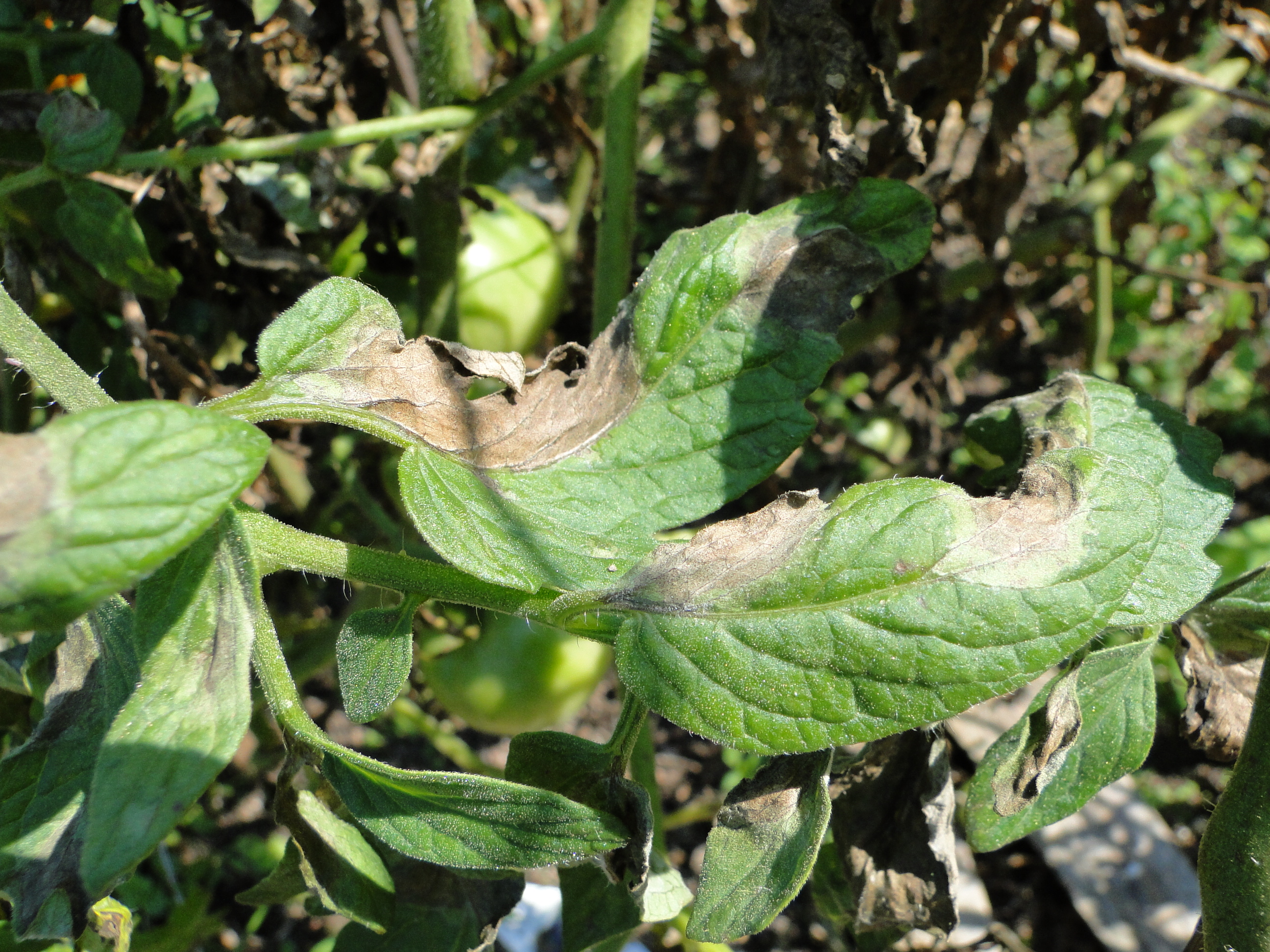


Since early spring, our office has been receiving numerous inquiries about browning of eastern cedar trees in Connecticut. Symptoms include distinctive off-color needles and tip diebacks. Upon close inspection and examination, no primary causing organisms were found on affected trees. This phenomenon was first observed in the state 2004 (see the linked fact sheet 2005 Update on the Eastern Red Cedar Problem) and has been recurring since then. Weather conditions and climate changes are considered possible contributors to eastern red cedar declines in the state, especially continuous summer drought stress and mild/and extreme cold winter temperatures. For more information, please see the fact sheet Browning, Dieback, and Decline of Eastern Red Cedar.


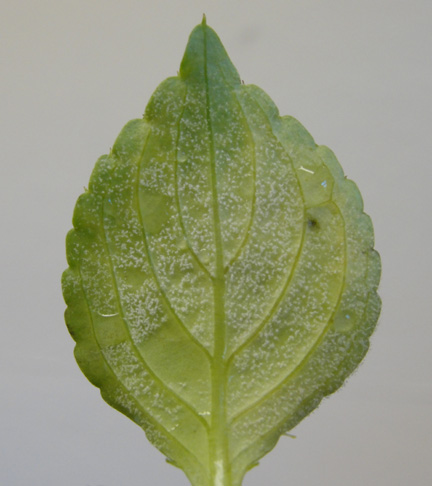
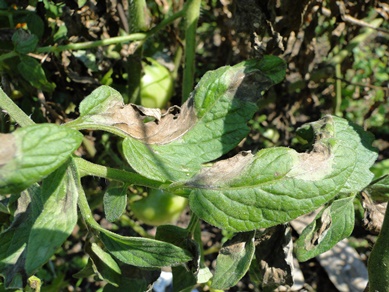
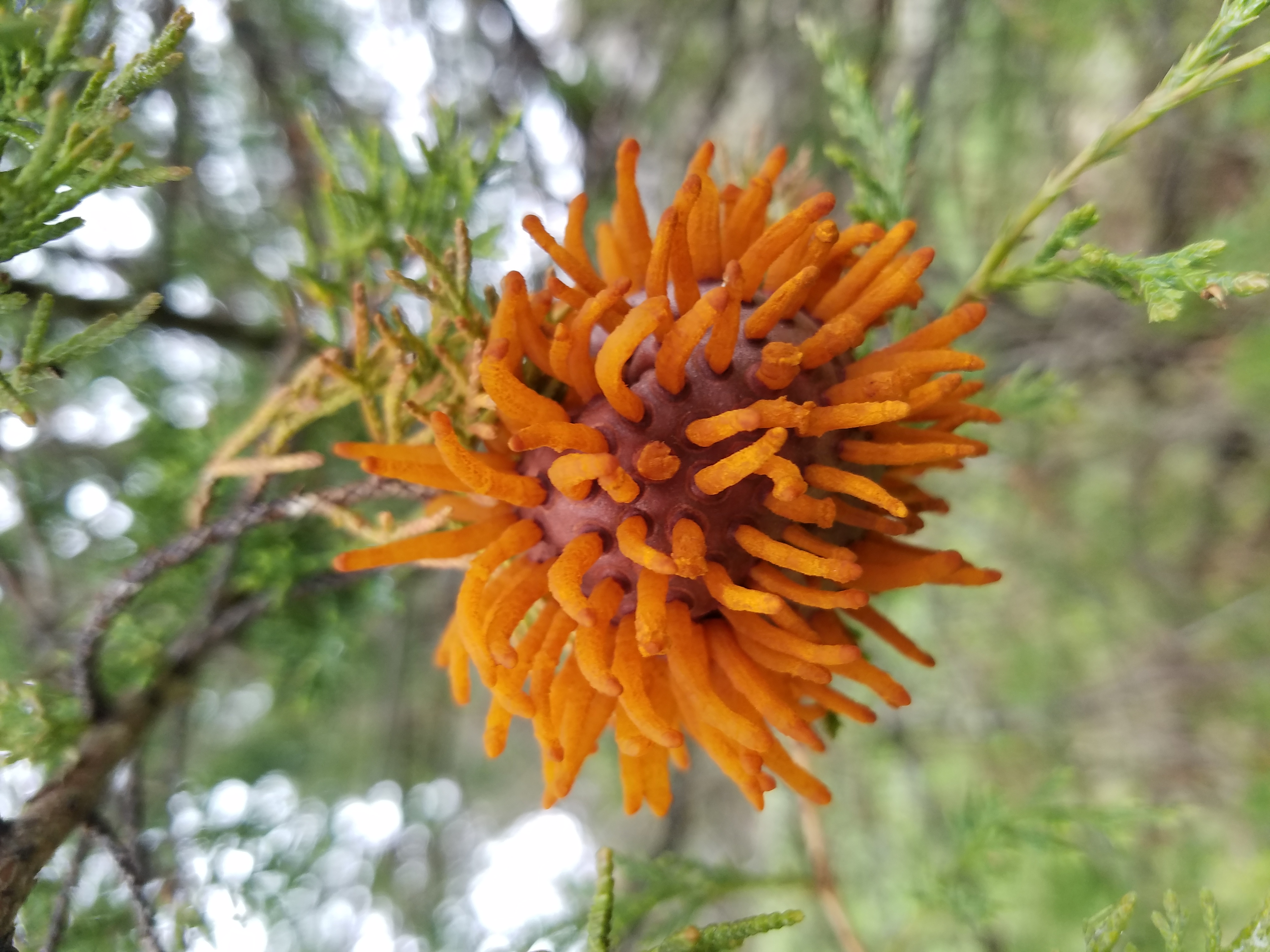
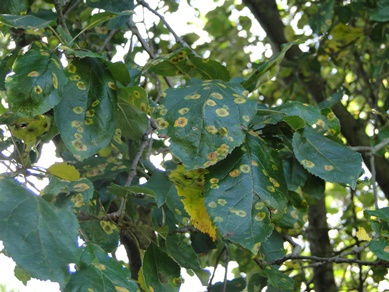
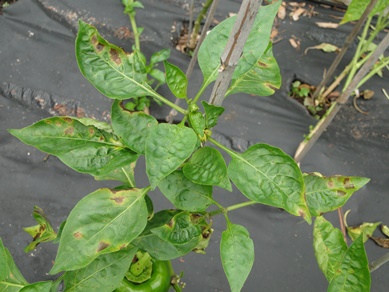

-Newly Expanded and Revised-
A newly revised and expanded disease management guide by Dr. Sharon M. Douglas, Emeritus Plant Pathologist, is now available. It can be downloaded to print hard copies or can used in electronic form with links. The Table of Contents includes: Host Genus and Disease Index, Host Common Name and Disease Index, Introduction to Use of the Disease Management Guide, An Introduction to Tree Health Problems, Common Tree Health Problems, Disease Management Guide, Disease Management Calendar, Fact Sheets, Disease Diagnosis, and Selected References. The Guide includes fact sheets with full color photos. Disease Management Guide for Connecticut Arborists 2015-2016
New Fact Sheet
This new fact sheet reviews one of the fundamental strategies for maintaining plant health and suppressing plant diseases by managing nutrition. Proper nutrition can often influence the fine line between host susceptibility and resistance. Examples of specific diseases and elements are covered in the fact sheet on Using Mineral Nutrition to Suppress Plant Diseases (PDF*format) by Dr. Wade Elmer.
June 2015
New Fact Sheet
Fire Blight Management During Bloom
Rhododendron tissue proliferation is a condition that causes tumor-like growths and shoots to form at the base of many cultivars of rhododendron. Early symptoms are often confused with crown gall, a disease caused by the bacterium Agrobacterium tumefaciens. A new fact sheet on Rhododendron Tissue Proliferation by Dr. Lindsay R. Triplett is now available that describes how to handle this condition.
Updated and Revised Fact Sheets Available
Last year many gardeners were disappointed with their basil crops--plants collapsed early in the season, often before they could be harvested. Widespread outbreaks of downy mildew of basil was the likely culprit. A new fact sheet on Downy Mildew of Basil by Dr. Yonghao Li is now available that discussed how to recognize and manage this destructive disease.
Dooks Needle Blight (Formerly Canavirgella Needlecast) of White Pine
Many white pine throughout the region have been showing a yellow and brown discoloration of current-season needles. Although several needlecasts have been associated with this damage, Canvirgella needlecast was reported as a key component. Recently, however, the identity of Canavirgella banfieldii has been questioned, since there is evidence that it is really Lophophacidium dooksii, the fungus associated with Dooks needle blight—the two names are thought to be synonyms for the same fungal species. Dooks Needle Blight (Formerly Canavirgella Needlecast) of White Pine by Dr. Sharon M. Douglas is now available.
Excess Water Problems on Woody Ornamentals
As the snow is melting, localized flooding may occur. Excess water and poorly drained soils can present serious problems for many woody ornamentals that may result in plant decline and death as well as uprooting of trees and large shrubs. Learn how to recognize and manage water issues in the newly updated fact sheet Excess Water Problems of Woody Ornamentals by Dr. Sharon M. Douglas.
Pruning- An Introduction to Why, How, and When
Pruning is probably one of the least understood and most daunting landscape maintenance practices for most homeowners. Many people aren't sure what to do or when to do it. This updated fact sheet reviews the basics of pruning for shrubs and small ornamental trees. Learn more about pruning with Pruning: An Introduction to Why, How, and When by Dr. Sharon M. Douglas.
Downy mildew is particularly destructive under moist conditions and cool nights--just the weather we have recently been having throughout the state.
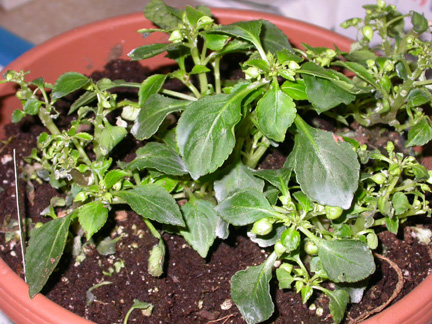
Impatiens downy mildew--note stunted plants with distorted leaves.
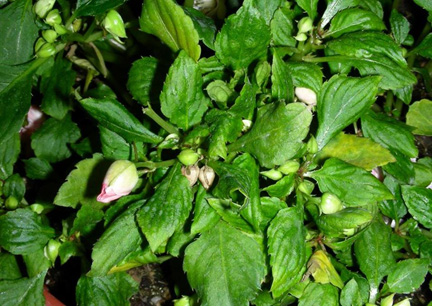
Subtle chlorosis and twisting of leaves of impatiens with downy mildew.
Any suspicious impatiens samples should be sent or brought to The Plant Disease Information Office for examination and diagnosis as soon as possible.
IF downy mildew is diagnosed on your plants, all infected plants should be dug (roots included) and placed into municipal trash, when acceptable. Infected plants should not be composted.
If you have any concerns or want more information about this destructive disease, please call The Plant Disease Information Office at 203.974.8601.
Late blight was confirmed in Franklin County, MA on tomato on 11 July 2013 and in Erie County, NY on tomato on 10 July 2013. The recent weather has been very favorite for this disease of tomato and potato, so it is important to scout for this destructive disease. It is very important for commercial growers and home gardeners to be on the lookout for late blight in their fields and community or backyard gardens. Information on this important disease can be found in the fact sheet Late Blight of Tomato and Potato in Connecticut--2012
Any suspicious tomato or potato samples should be sent or brought to The Plant Disease Information Office for examination and diagnosis as soon as possible.






















